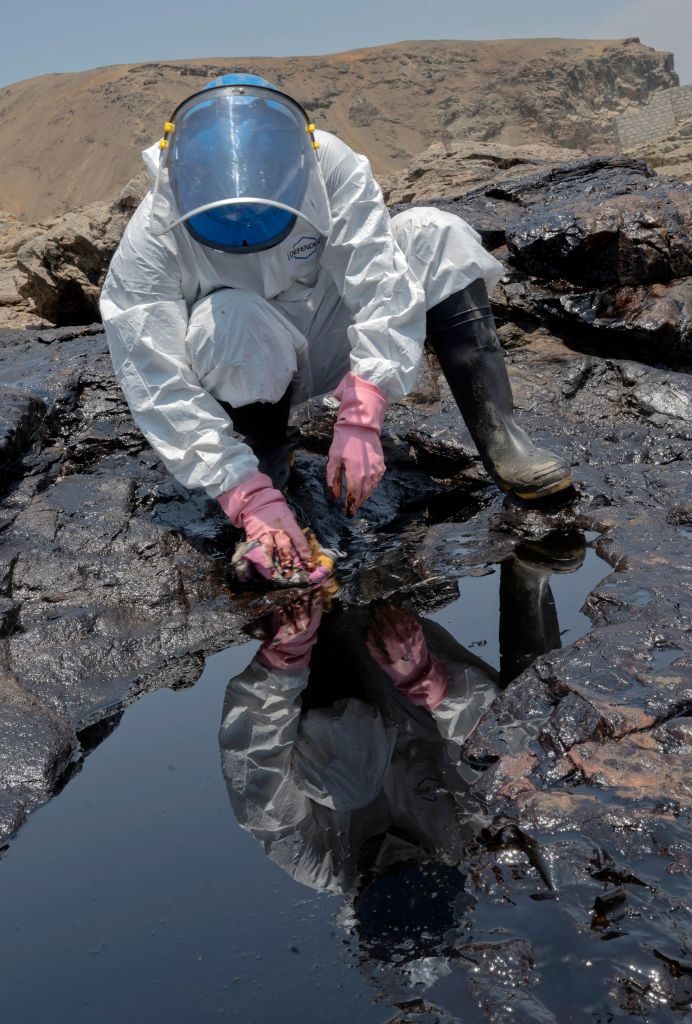A Peruvian oil tanker spilled much of its contents into the waters of the Pacific Ocean on Saturday affecting at least two miles of Peru’s central coast after waves sparked by Tonga’s volcanic eruption and tsunami that day in the South Pacific rocked the actively discharging ship, Peruvian government officials said Monday.
“[Peru’s] National Institute of Civil Defense (Indeci) and the emergency center of the Ministry of Energy and Mines said in a statement that high tides recorded in Ventanilla, as a result of the [Tongan] volcano’s eruption, had altered the process of unloading crude oil for the refinery,” Reuters reported on January 17.
Peruvian Environment Minister Ruben Ramirez visited one of the main oil spill sites in the Peruvian municipality of Ventanilla on January 17 to assess the damage caused by the accident.
“It is unfortunate. I am seeing that there is a serious impact on the coastal marine area. Initially two and a half kilometers [1.6 miles] (of damage) were reported, but now we see that it has affected two [additional] beaches,” Ramirez told reporters.
Agence France-Presse (AFP) quoted Ramirez on January 18 as saying the oil spill affected a “two-mile stretch [of Peruvian coast] along three beaches.”
Ventanilla Manager of Citizen Security Fernando Ramirez told Canal N, a Peruvian TV news channel, local officials first learned of the oil spill on the afternoon of January 16, or about 24 hours after the oil tanker in question was disturbed by the Tongan origin waves.
“At one in the afternoon we learned that there was an oil spill, because on this side of the beach there was a strong smell of fuel,” he told Canal N. “For this reason, in prior coordination with the [local] police, the aquatic rescue unit and our lifeguard personnel from the municipality entered the interior of the beach,” he detailed.

Cleaning crews work to remove oil from a beach in the Peruvian province of Callao on January 17, 2022, after a spill which occurred during the unloading process of the Italian-flagged tanker “Mare Doricum” at La Pampilla refinery caused by the abnormal waves recorded after the volcanic eruption in Tonga. (CRIS BOURONCLE/AFP via Getty Images)
The task force has since erected several “containment barriers of approximately 500 meters in length” along Ventanilla’s beaches to prevent the spilled oil from seeping further inland. The team further deployed “three vessels that were cleaning and collecting oil in the area” as of January 17, according to Canal N.
“Ships worked on collecting oil still floating in the water, while workers in protective gear began cleaning oil that had washed ashore,” AFP reported of the Peruvian government’s recovery efforts on January 18.
“Elsewhere in Peru, two women drowned after being caught in waves caused by the volcanic eruption in Tonga,” the news agency recalled on Tuesday. The deaths occurred off a northern Peruvian beach, according to Reuters.
A volcanic eruption in the South Pacific island nation of Tonga obliterated the kingdom’s uninhabited island of Hunga-Tonga-Hunga Ha’apai on January 15. The eruption’s vibrational impact caused a tsunami in Tonga that subsequently reverberated in the form of massive ocean waves that reached the Pacific coasts of Peru and Chile 6,600 miles away in mere hours. The natural phenomenon was felt through either sound or water waves across Pacific-adjacent nations over the weekend, including Japan and the U.S.

COMMENTS
Please let us know if you're having issues with commenting.